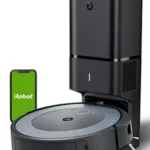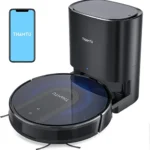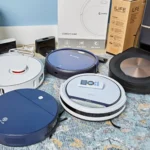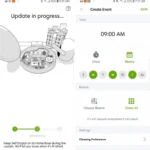Have you ever wondered about the difference between bagged and bagless automatic dirt disposal systems in smart vacuums? With so many options available on the market, it can be perplexing to choose the best type of dirt disposal system for your needs. The bagged system collects debris in a disposable bag, while the bagless system uses a dustbin to store the dirt. Both options have their advantages and disadvantages. In this article, we’ll explore the workings and types of bagged and bagless automatic dirt disposal systems, compare them, and help you decide which one is the best fit for you.
Bagged Automatic Dirt Disposal System
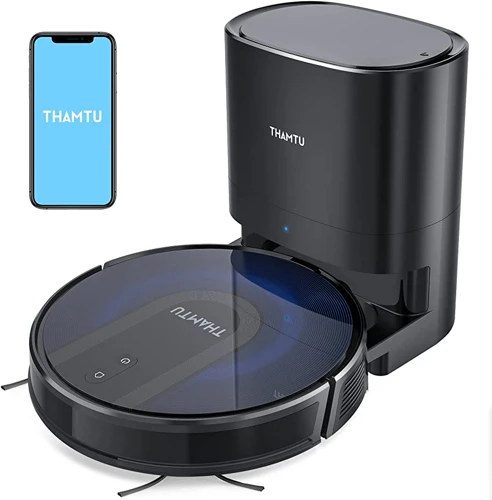
When it comes to choosing a smart vacuum with an automatic dirt disposal system, you have two options: bagged or bagless. In this section, we’ll take a closer look at the bagged automatic dirt disposal system and explore how it works, its pros and cons, and the types of bagged dirt disposal systems available on the market today. For those who are experiencing issues with their smart vacuum’s automatic dirt disposal system or want to learn more about maintaining it, check out our guide on smart vacuum automatic disposal troubleshooting and maintenance tips.
How does it work?
When it comes to bagged and bagless automatic dirt disposal systems in smart vacuums, the way they work is quite different. Let’s start by discussing bagged systems.
Bagged Automatic Dirt Disposal System uses a disposable bag that collects dirt and debris while you vacuum. The bag is placed inside the vacuum and connected to the dirt canister through a tube or port. When the vacuum is in use, the dirt and debris are sucked into the bag and stored there until it’s full. After the bag is full, it needs to be replaced.
The replacement process can vary depending on the specific model of vacuum. Some vacuums require you to remove the entire canister, while others have a separate opening for the bag. Once the bag is removed, it’s important to properly dispose of it to prevent any potential spread of allergens or dust. This usually requires sealing the bag and placing it in the trash.
Bagless Automatic Dirt Disposal System, on the other hand, doesn’t use a disposable bag. Instead, it uses a dirt canister that collects the dirt and debris. The canister is made of a transparent material so you can see when it’s full and needs to be emptied.
When the canister is full, you need to properly empty it to ensure proper functionality of your vacuum. The process of emptying the canister involves removing it from the vacuum, opening the lid or bottom, and emptying the contents into a garbage bin. It’s important to empty the canister regularly to avoid clogs or loss of suction power.
Factors to Consider when deciding between bagged and bagless systems include the level of convenience, the cost, air filtration, and environmental impact. Bagged systems are often more convenient as you simply need to replace the bag when it’s full, whereas bagless systems require you to empty the canister more often. However, bagless systems can save you money in the long run as you don’t need to purchase replacement bags. Additionally, bagless systems typically have better air filtration as there are no small crevices in the bags where dust and allergens can accumulate over time. Finally, when it comes to the environmental impact, bagless is the better option, as you won’t be contributing to the landfills with spent bags.
Before purchasing a smart vacuum, consider these factors carefully and determine which system is better suited for your home and lifestyle. Your vacuum’s performance is also dependent on regular maintenance and cleaning, including cleaning and replacing filters, cleaning dustbins, properly emptying the dustbin, cleaning vacuum brushes, and maintaining the sensors. To learn more about these topics, visit /cleaning-replacing-filters-smart-vacuums/, /properly-empty-dustbin-smart-vacuum/, /clean-smart-vac-brushes/, /top-smart-vacuum-accessories/, and /clean-maintain-smart-vacuum-sensors/.
Pros and Cons
When it comes to choosing between a bagged and bagless automatic dirt disposal system in smart vacuums, there are pros and cons to consider for both options. Let’s take a closer look at each.
| Pros of Bagged Systems | Cons of Bagged Systems |
|---|---|
| Less Mess: Bagged systems typically create less mess when it comes time to dispose of the dirt and debris. | Higher Maintenance Costs: Replacement bags can add up and increase the overall maintenance costs of bagged systems. |
| Better Filtration: Bagged systems are known for having better filtration, as the bag itself is an additional filter to trap fine particles. | Less Convenient: When the bag is full, it needs to be replaced, and this can be time-consuming and inconvenient. |
| Less Odor: Because the dirt and debris are sealed in a bag, bagged systems tend to produce less odor than bagless systems. | Reduced Suction Power: As the bag fills with dirt, it can reduce the suction power of the vacuum, affecting its effectiveness. |
| Pros of Bagless Systems | Cons of Bagless Systems |
|---|---|
| Less Costly: Bagless systems, as the name suggests, don’t require bags, so there’s no need to purchase replacement bags. | Inferior Filtration: Bagless systems can have inferior filtration, as there is no bag to trap fine particles, so they can escape back into the air. |
| More Convenient: With bagless systems, the dirt and debris are deposited directly into a bin, and when it’s full, it can be easily emptied and replaced. | More Messy: Emptying a bagless bin can be messy and can create dust clouds, which can be irritating for those with allergies or respiratory problems. |
| Better Suction Power: Because there are no bags to fill up, bagless systems can maintain their suction power, resulting in a more effective vacuum. | More Odor: As there is no bag to seal in the dirt and debris, bagless systems can produce more odor, especially if the bin is not emptied regularly. |
As you can see, each type of system has its own set of pros and cons. What works for one person might not work for another, so it’s important to consider your personal needs when deciding which type of system to choose.
Types of Bagged Dirt Disposal System
When it comes to bagged automatic dirt disposal systems, there are different types available in the market. Each type has its unique features and benefits. Let’s take a look at some of the most popular types of bagged dirt disposal systems.
Type 1: Replaceable Full-Bag System
This type of system features a replaceable full bag that can be easily swapped out when it gets filled with dirt and dust. This design ensures that you never have to come in contact with the dust and dirt while changing the bag. The replaceable full-bag system is a convenient option for those who want a hassle-free way to empty their vacuum cleaner.
Type 2: Replaceable Half-Bag System
This type of system is similar to the replaceable full-bag system, but it uses a half bag instead. The half-bag design is smaller and more compact, which makes it ideal for those who want to save space. It can be replaced easily, and you don’t have to worry about dust and dirt flying out into the air.
Type 3: Self-Sealing Bag System
The self-sealing bag system is a popular option for those who want to minimize dust and dirt exposure. The bag is sealed when you remove it from the vacuum, which means that you’ll never have to come in contact with the contents. This system is particularly useful for those with allergies, as it helps to minimize airborne allergens.
Type 4: Cyclonic Bag System
The cyclonic bag system is a unique design that uses cyclonic action to separate the dirt and dust from the air. The bag is then used to collect the dirt and dust, keeping it from escaping into the air. This system is particularly effective at keeping your home clean, as it filters out more dirt and dust compared to other systems.
Type 5: Multi-Bag System
The multi-bag system is a more advanced version of the replaceable bag system. This system features multiple bags that can be easily replaced when one gets filled with dirt and dust. This design ensures that you always have a fresh bag, and you don’t have to worry about running out of room for dirt and dust.
Each type of bagged dirt disposal system has its unique advantages and disadvantages. Consider your cleaning needs and preferences before choosing the right system for your home.
Bagless Automatic Dirt Disposal System
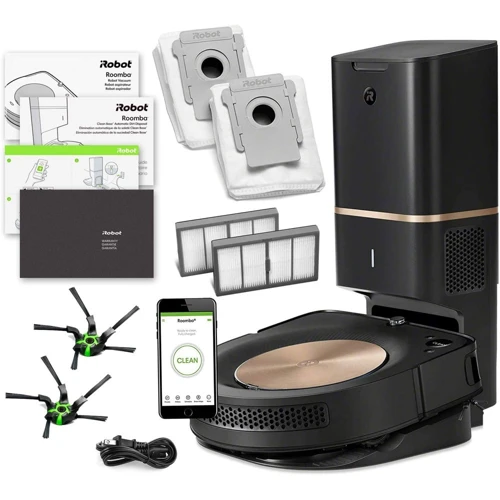
If you’re looking for a more advanced approach to cleaning, then you may want to consider a bagless automatic dirt disposal system. This innovative technology is quickly becoming popular among smart vacuum users due to its powerful suction, efficient filtration, and convenient dirt disposal process. With a bagless system, you won’t have to worry about buying and replacing messy vacuum bags. Instead, the dust and debris are compressed and stored in a container that can be easily emptied. In this section, we’ll explore the working mechanism, benefits, and downsides of bagless automatic dirt disposal systems, as well as the different types available on the market.
How does it work?
When it comes to automatic dirt disposal in smart vacuums, there are two main types – bagged and bagless systems. Both systems have unique features that make them efficient in their own way.
Bagged Automatic Dirt Disposal System:
This system comes with a disposable bag installed inside the dirt canister. Once the vacuum cleaner reaches its maximum capacity, the dirtbag is automatically sealed and ejected into the trash.
Here’s how it works:
- A sensor detects when the canister is full
- The vacuum cleaner sends a signal to the dirtbag to seal
- The dirtbag is ejected into the garbage can, making it easy to dispose of debris.
Pros and Cons:
- Pro: This system is ideal for people with allergies as the bag acts as a filter, trapping dust and allergens inside.
- Pro: Bagged systems are generally easier to clean and maintain as the user only needs to dispose of the bag when full.
- Con: Usage of bags – over time can be expensive as the user will need to purchase additional bags when the previous one is full.
- Con: The suction power of the vacuum cleaner may decrease once the dirt bag is almost full and the user will need to replace it with a full one to maintain high suction power.
Types of Bagged Dirt Disposal System:
There are two main types of bagged dirt disposal systems which include:
- Disposable bags – These are single-use and designed for quick and easy disposal of dirt and debris.
- Reusable bags – These bags can be emptied and reused multiple times. They require careful maintenance as the user must manually dispose of the dirt properly.
Pros and Cons
When it comes to choosing between a bagged and bagless automatic dirt disposal system in a smart vacuum, it’s important to consider the pros and cons of each. Here are some key points to keep in mind:
Bagged Pros:
- Less messy – Bagged systems keep all the dust and debris inside the bag, making it less messy to dispose of.
- Better for allergy sufferers – The bag traps allergens better than a bagless system which can allow dust and debris to escape when emptying.
- Less frequent replacement – Bags can typically hold more dirt and debris than a bagless system, meaning they need to be replaced less frequently.
Bagged Cons:
- More expensive in the long run – Bags need to be purchased regularly, which can add up over time.
- Less environmentally friendly – Adding to the landfill is not an eco-friendly option, although bags made from recycled materials can reduce this impact.
- Reduced suction power – As the bag fills up, it can reduce the suction power of the vacuum, reducing its effectiveness.
Bagless Pros:
- Eco-friendly – Since there’s no bag to throw away, it can be a more environmentally-friendly option.
- Cost-effective – There are no bags to purchase, saving you money. Emptying the dustbin is easy, so you won’t need to buy new ones frequently.
- Convenient – Since there is no need to replace bags or remember to purchase them, bagless systems can be more convenient.
Bagless Cons:
- More messy – Emptying the dustbin can create a cloud of dust and debris, potentially causing respiratory issues if inhaled.
- Poorer air filtration – Bagless systems don’t filter as well as a bagged system, allowing more dirt, debris, and allergens to escape into the air.
- Frequent maintenance – Filters need to be cleaned or replaced regularly to maintain suction power.
It’s important to weigh these pros and cons before making a final decision on which type of automatic dirt disposal system to choose for your smart vacuum. Consider your priorities and lifestyle, such as how often you vacuum, whether you have allergies, and how environmentally conscious you are.
Types of Bagless Dirt Disposal System
When it comes to bagless automatic dirt disposal systems, there are a few different types to consider. Let’s take a closer look at each one and their unique features and benefits:
| Cyclonic Separation System | The cyclonic separation system uses centrifugal force to separate dirt and debris from the air. As the air and debris enter the vacuum’s chamber, the cyclonic motion separates the two, with the debris being forced to the outer wall of the chamber, where it falls into a collection bin. |
| Filter-Based System | In a filter-based system, the air and dirt are drawn into the vacuum’s chamber through a filter. The filter traps the dirt and debris, while the air is pushed through and back into the room. The collected dirt can then be easily emptied from the filter onto a trash bag or bin. |
| Point of Contact System | With a point of contact system, the vacuum’s brushes and rollers come into direct contact with the dirt and debris on the floor. As they pick up the dirt, it is transferred into a collection bin inside the vacuum. Once the bin is full, it can be easily removed and emptied. |
Each of these types of bagless automatic dirt disposal systems has its advantages and disadvantages. It’s important to consider your specific cleaning needs and preferences when choosing the right system for you.
Bagged vs Bagless Automatic Dirt Disposal System
Now that we’ve taken a closer look at both bagged and bagless automatic dirt disposal systems, it’s time to compare the two and determine which one is truly the better choice for your smart vacuum. Both systems have their unique advantages and disadvantages, and it’s important to consider these carefully before making a final decision. In this section, we’ll delve into the bagged vs bagless debate, highlighting the key differences between both systems and providing insight into which one might be the superior choice for your needs. Let’s dive in!
Which one is better?
When it comes to choosing between a bagged and bagless automatic dirt disposal system in smart vacuums, the answer isn’t as clear cut as you might think. Both systems have their own unique advantages and drawbacks that are worth considering before making a decision.
Advantages of Bagged Systems:
- The sealed bag design ensures that allergens and dust are trapped inside, which can be particularly beneficial for individuals with allergies or asthma.
- The bags are typically larger than the dustbins in bagless systems, meaning less frequent trips to empty the dirt.
- When it’s time to replace the bag, it’s a simple and mess-free process – just remove and dispose of the bag.
Disadvantages of Bagged Systems:
- Replacing bags can be a recurring cost, which may become expensive over time.
- The sealed bag design can decrease the suction power of the vacuum over time, as the bag fills up.
- It can be difficult to tell when the bag is full, as there is no visual indicator like there is in bagless systems.
Advantages of Bagless Systems:
- There are no recurring costs associated with buying new bags.
- The transparent dustbin design allows you to see when it’s time to empty the container.
- Because there is no bag to restrict airflow, bagless systems may have more consistent suction power over time.
Disadvantages of Bagless Systems:
- Emptying the dustbin can be a messy process, as dirt and dust can spill out.
- Individuals with allergies or asthma may be more sensitive to dust and allergens being released during the emptying process.
- The dustbins are typically smaller than bags, meaning they must be emptied more frequently.
Factors to Consider:
Ultimately, the decision between a bagged and bagless automatic dirt disposal system in a smart vacuum will depend on individual needs and preferences. Consider factors like budget, frequency of use, and sensitivities to dust and allergens. It’s also important to weigh the recurring cost of buying new bags versus the time and effort required for more frequent emptying of the dustbin. By weighing the advantages and disadvantages of each type of system, you’ll be able to make an informed decision that works best for you.
Factors to Consider
When choosing between a bagged and bagless automatic dirt disposal system for your smart vacuum, there are several factors to consider. Here is a handy table to help you weigh the pros and cons of each option:
| Factor | Bagged | Bagless |
|---|---|---|
| Noise Level | Generally quieter, as the dirt is trapped inside the bag | Can be noisier, as the dirt is emptied into a bin |
| Cleaning Cost | May require ongoing purchase of replacement bags | No need to purchase bags, but may require cleaning of filters |
| Environmental Impact | The bags are disposable and may end up in landfills | May generate more dust in the air during emptying and may require filter replacement, which may contribute to environmental impact |
| Cleaning Efficiency | May have stronger suction power and trap more dirt with the use of the bag | May have less suction power and accumulate dirt more quickly in the dustbin, requiring more frequent emptying |
| Convenience | May require less frequent emptying and disposal of bags, resulting in less hassle and mess | No need to purchase bags, but may require more frequent emptying and cleaning of filters |
As you can see, both bagged and bagless automatic dirt disposal systems have their advantages and disadvantages. Consider your priorities and needs when making your decision. If you place importance on noise level and cleaning efficiency, a bagged system may be the better choice. If convenience and cost are your priorities, a bagless system may be more suitable. Ultimately, the decision will depend on your personal needs and preferences.
Conclusion
After discussing bagged and bagless automatic dirt disposal systems in smart vacuums, it becomes evident that both the systems have their own set of pros and cons. The decision to choose between bagged and bagless automatic dirt disposal systems ultimately comes down to individual preferences and needs.
Bagged systems offer the convenience of a disposable bag, making it easy to dispose of all the dirt particles in one go. These systems also help in maintaining a cleaner and hygienic vacuum, as the dirt is contained inside the bag. However, the downside is the recurring cost of purchasing bags, which can add up over time, leading to additional expenses.
Bagless systems are a more eco-friendly option, as they do not require disposable bags, reducing waste. These systems also offer the convenience of visualizing the dirt collected inside the vacuum, allowing users to clean the dirtbin promptly. However, bagless systems may require more frequent cleaning and maintenance, as the filters and dirtbins need to be emptied and washed frequently.
When comparing both systems, it’s important to consider factors such as the frequency of use, the types of surfaces the vacuum will be used on, and the level of convenience needed. Factors such as cost, environmental impact, and maintenance requirements should also be considered.
In conclusion, there is no one-size-fits-all solution when it comes to choosing between bagged and bagless automatic dirt disposal systems. It ultimately comes down to personal preferences and needs. Nevertheless, smart vacuums equipped with automatic dirt disposal systems offer an efficient and convenient way to keep homes clean, whatever the choice of dirt disposal system may be.
Frequently Asked Questions
1. How often do I need to replace the bag in a bagged automatic dirt disposal system?
It depends on how often you use your vacuum and how much dirt and debris it collects. Generally, bags should be replaced when they’re about two-thirds full to ensure optimal performance.
2. Can I use generic bags in my bagged automatic dirt disposal system?
It’s best to use the manufacturer’s recommended bags to ensure proper fit and optimal performance. Using generic bags may result in reduced suction power and decreased efficiency.
3. Do bagged automatic dirt disposal systems require more maintenance than bagless systems?
Bagged systems may require more maintenance as the bags need to be replaced periodically. However, they tend to be more hygienic and have better filtration than bagless systems.
4. How often do I need to empty the dustbin in a bagless automatic dirt disposal system?
It depends on how often you use your vacuum and how much dirt and debris it collects. Generally, the dustbin should be emptied after each use to ensure optimal performance.
5. Can I reuse the filters in my bagless automatic dirt disposal system?
It’s best to follow the manufacturer’s recommendations for filter replacement. Some filters may be washable and reusable, while others may need to be replaced periodically for optimal performance.
6. Do bagless automatic dirt disposal systems have better suction power than bagged systems?
Not necessarily. The suction power of a vacuum depends on various factors, such as the motor and design of the machine, rather than whether it’s bagged or bagless.
7. How do bagged and bagless automatic dirt disposal systems differ in terms of cost?
Bagged systems tend to be more expensive in the long run as you need to purchase replacement bags, while bagless systems typically only require occasional filter replacements. However, the initial cost of a bagless system may be higher than that of a bagged system.
8. Can a bagged automatic dirt disposal system be converted to a bagless system?
No, it’s not possible to convert a bagged system to a bagless system as they have different mechanisms for disposing of dirt and debris.
9. Are bagless automatic dirt disposal systems more environmentally friendly?
Bagless systems may be considered more environmentally friendly as they don’t require disposable bags. However, they may produce more dust and allergens during the emptying process, which can be harmful to those with respiratory issues.
10. Which type of automatic dirt disposal system is best for homes with pets?
Both bagged and bagless systems can be suitable for homes with pets. However, bagged systems with high-quality filtration may be better at containing pet dander and allergens. Bagless systems with washable filters may also be a good choice as they can effectively capture pet hair and dirt.


